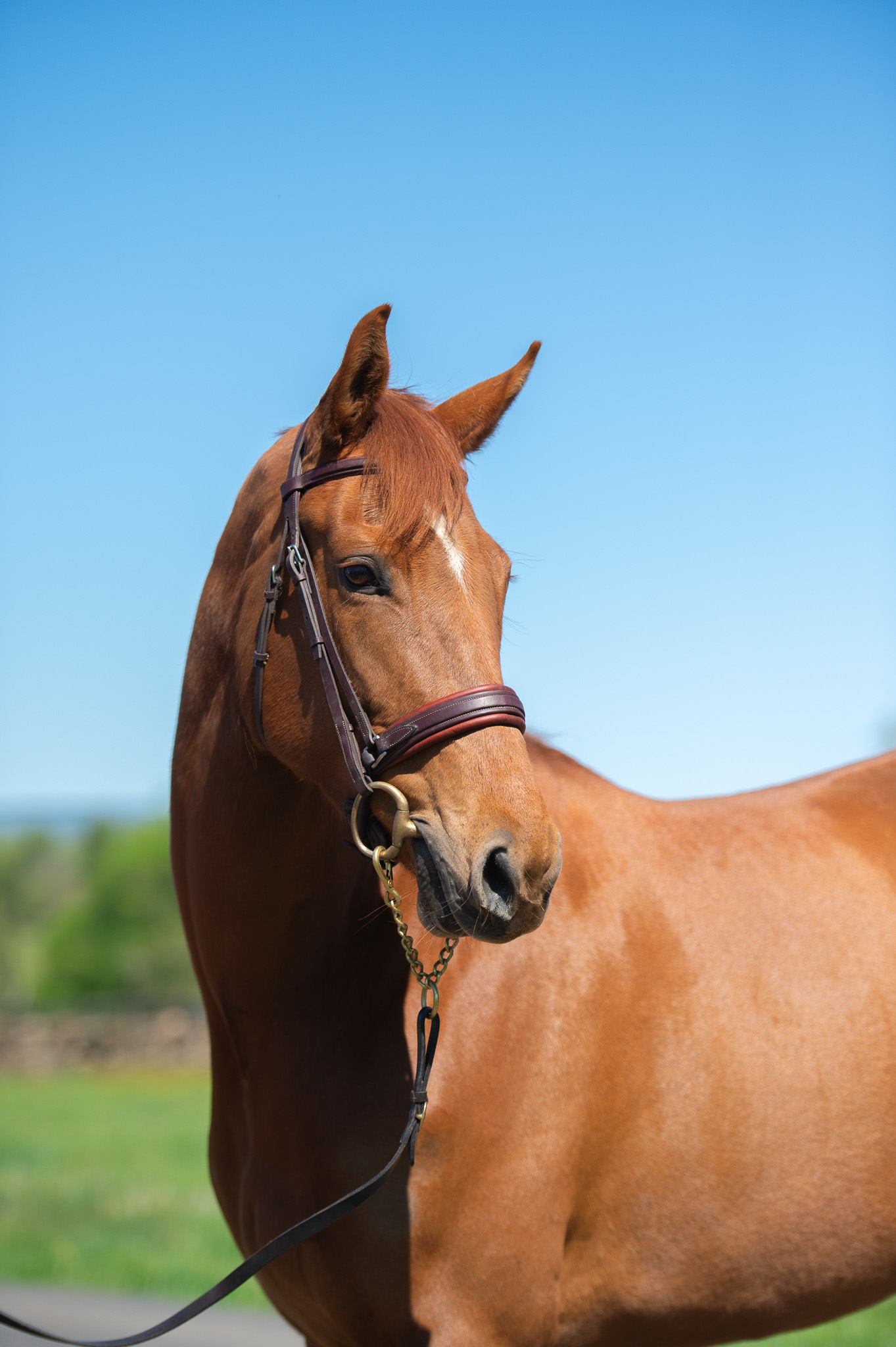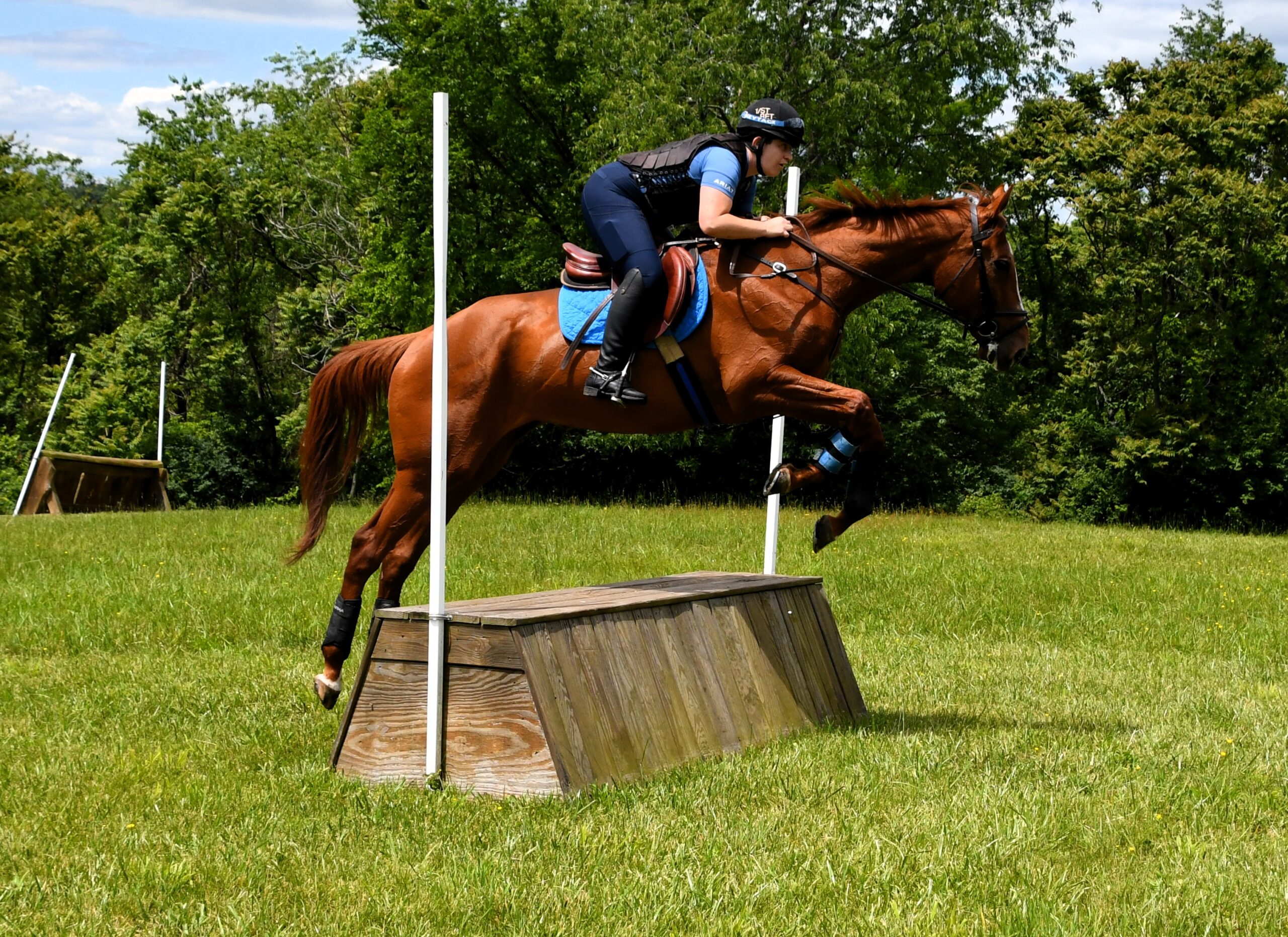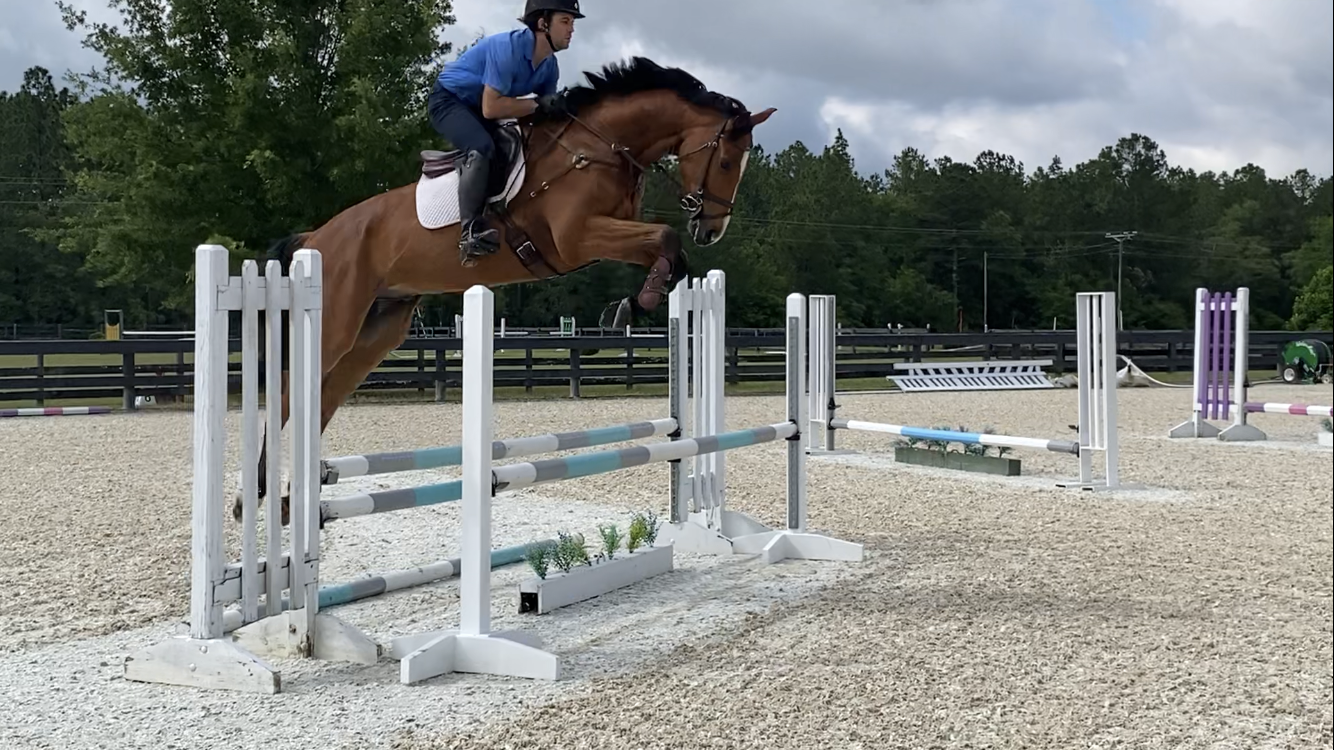“You wouldn’t necessarily look at this and think it’s frangible, would you?” asks Stuart Buntine, director of event organisation company BEDE Events. He’s gesturing to a wide, particularly solid-looking table, which will be placed out on course for next week’s Thoresby Spring Carnival of Eventing, BEDE’s crown jewel event. And he’s not wrong – though frangible tables are a relatively new addition to eventing’s stable of safety technology, they’re generally recognisable by their visible mechanisms and those distinctive red MIM clips that make the whole thing function.
Here, though, is a table that looks, well, like a table – and it’s not until you get much closer, and perhaps down onto your knees in the grass, that you’ll spot a little window through which you can see (and, more importantly, access) the MIM. That window is crucial: it’ll allow fence judges, who’ve been briefed on how exactly to wiggle a MIM to work out if a hard knock has weakened it, to do exactly that between horses, avoiding – as much as is possible, anyway – the ‘soft knocks’ and preventable activations that keep some competitors on the fence about this kind of technology.
So that’s phase one of Stuart’s plan: the aesthetics of safety.
“I would love to get back to traditional cross-country fences,” he confesses. “There’s some stuff I did with Mats last year that I’d love to do with natural rails, bent rails, twisted rails. We’ve nearly got them approved now. It always comes back to this: if you can build a fence, can you make it frangible? [Our ethos is] let’s try, and then we know if we can use it as a frangible or not.”
Mats – tall, smiley, and Swedish – is Mats Björnetun, the man behind the MIMS. He founded MIM Construction AB in 1986 with the automotive industry in mind; for years, he and his team created innovative products to keep people safer behind the wheel of a car. But eventing was never far from his mind, thanks to a keen interest in the sport that saw him join organising committees in his home country throughout the 90s.
Bringing safety technology, his area of expertise, to eventing, his area of interest, was a slow process, though, and it wasn’t until 2013 that the MIM clip was approved for use by the FEI, adding an extra dimension of risk-avoidance to the extant frangible pin, which had been in use on post-and-rail fences since 2002. Where frangible pins break only under vertical force, MIM clips can be activated from either vertical or horizontal impact. Both ultimately aim to do the same thing: in each use case, the deformable part of the fence will collapse under significant force, which allows for a disruption to the trajectory of a horse’s fall, allowing them to get a front leg out in front of them and stabilise themselves or, at the very least, twist in mid-air into a less injurious tumble. Either option is significantly more desirable than a true rotational fall, in which an unimpeded trajectory sees a horse’s momentum channeled into flipping it in mid-air so that it lands directly on its back, often with the rider directly beneath it and taking the full brunt of the fall.
In true rotational falls, much existing safety technology doesn’t stand a chance. Air jackets, which can provide crucial additional shock absorption in many types of falls, are reliant on a split-second moment in which the rider is separated from the saddle, which pulls the activation cord and inflates the vest. In a true rotational fall, the rider doesn’t leave the saddle at all, and is left with minimal physical defenses from the impact of 500+ kilograms of horse, plus the cruelty of inertia. The statistics around rotational falls make for grim reading: in most rider fatalities, this type of fall trajectory is the culprit, and in 1999, British Eventing’s annus horribilis, four of the five riders who lost their lives did so as the result of a rotational. But, more hearteningly, in the twelve years since the introduction of MIM technology, the number of rotational falls is in decline: in 2011, two years pre-MIM, 0.2% of starters suffered a rotational fall. In 2022, that figure went down to 0.07%, effectively making it three times less likely that a rider would have one.
The work is, of course, not even close to done, and life-changing accidents are still all-too common in eventing. While MIM clips are an increasingly common site on upper-level courses now – most airy oxers and corners will have them, with the latter sporting more sensitive yellow MIMs, introduced in 2017 – there’s still a wide swathe of fence types that aren’t collapsible.
But after the introduction of the collapsible table, which we’ve seen in action at both the Land Rover Kentucky Three-Day Event and the MARS Badminton Horse Trials, an awful lot more innovation started to look possible. As Stuart introduces us to his new fence designs, all of which will be used at Thoresby, there’s at least one moment in which the obviousness of it all smacks us in the face: of course we could make this collapsible. Why didn’t we just try?

The underside of the hanging log fence.
His new-design fences, cooked up after plenty of time in the workshop with Mats, include a solid arrowhead, a roll-top, a sheep-feeder and, perhaps most poignantly, a hanging log, which looks formidable and untouched, but if you crawl underneath it, you’ll see that it’s completely hollowed out.
“It’s a quick job for a sawmill to do, once they’ve worked it out,” says Stuart. Effectively, the hollowing removes 50% of the log’s weight, making the physics of the horse vs fence dilemma work much more in the horse’s favour. Then, like any frangible fence, it’ll lower – the magic number, Mats tells us, is just a 20cm deformation in order to positively alter a horse’s trajectory – and, with any luck, save a life.
Its addition to the roster of MIM-equipped fences is poignant because among our small group of event organisers and journalists are Jo Williams and Debbie Strang, sister and mother, respectively, of the late Georgie Campbell. It was just in May of last year that Georgie tragically lost her life in a cross-country accident at Bicton Horse Trials, jumping just this kind of fence: a sturdy hanging log into the water, over which she and her horse had a slow rotational. The fence wasn’t frangible; at the time, no fences of this type were or ever had been, and much of the ‘old guard’ response to whether it should have been came down to a singular idea, and one that has, perhaps, been the rope around modern eventing’s neck: that just isn’t something that’s done.
Now, though, it is. By October, a frangible trakehner design had been created, tested, and approved, and was in use at the Aspen Cooling Osberton International Horse Trials, another BEDE event under Stuart’s leadership and utilising his course design skills. This kind of innovation and refusal to stick to what’s always been done is something that Georgie’s family has taken an active interest in supporting.
“In the aftermath of Georgie’s death, we started looking at how we could create a foundation in her name,” says Jo, who now helms the fledgling Georgie Campbell Foundation. “Initially, we started looking at how we could support people starting eventing businesses, and that was probably the comfortable thing to look into in those early days. Probably, we’d parked the safety question because it was a bit too painful to go there, but it’s evolved over time, and it makes a lot of sense for us to align Georgie’s story and that personal element with a push towards increased frangibles and reduced rotational falls.”
Now, as the Foundation submits its Charity Commission application and prepares to evolve from its embryonic early stages, supporting safety technology initiatives is very much part of its model. That’s no small feat: for now, Jo explains, she’s navigating the complexities of the sport’s global and national governing bodies and having conversations with other families in similar positions, including the Meheust family, whose daughter, Thaïs, died in 2019 at the age of 22. The Ride for Thaïs charity now focuses solely on fundraising for safety technology.
In researching the loose ends in safety innovation, Jo has stumbled upon a lack of cohesion between groups and countries that, if addressed, could allow for greater combined efforts to improve safety statistics across the sport.
“I personally think there’s lots of great things going on across the world in this space, but maybe they’re not as joined up as they could be at the moment,” she says. “The University of Kentucky has done a whole study in the US; there are different things going on in different countries. But it feels to me that we need to pull together so that the investment in those things can be shared globally.”
“Something I’ve definitely seen in my professional life,” she continues, “is that what gets measured, gets done. And how compelling it is to have a goal. So for me, it feels like it needs all that detail, and kind of a roadmap, or a baseline to flesh out around where we are right now. How many fences have frangibles? Where do we want to get to? What does success look like? Which types of fences, which types of events – we want to reach out to the GCF audience to ask for funds, but we want to be really clear about where that money is going, and how it could help.”
For now, it’s clear that much of that kind of forward thinking is happening in two workshops – one in Sweden, and one in the UK. Over on Scandinavian shores, Mats comes up with his own ideas, which he can then show to Stuart, who either moves ahead with them or decides to go in a different direction. Equally, he’s used to picking up the phone to his friend and co-conspirator, who rings him with thoughts and ideas – a back-and-forth of ‘what ifs’ and prototypes. It was that back-and-forth that led to the development of what Stuart calls ‘the parallelogram’ – “that might not actually be the correct word,” he says with the grin of someone who may have skipped a high school geometry class or two to ride horses – a MIM-driven foldable structure that allows these new, more complex designs to safely deploy.

The parallelogram before being deployed…

…and after.
Then, with the parallelogram perfected, course builders Will Seely and Chris Eaton were able to get on with building their own prototypes, bringing ideas from across the board to life and discovering what works and what might need to wait for the next innovative design.
“We said, ‘how can we do something different?’,” says Chris. “Stuart wanted to make a bit of a triple brush, but without the brush, and he said, ‘can we do that?’ He came to me and said, ‘right, I’ve been thinking about this overnight,’ and he got a Christmas card he’d been about to throw away, and he chopped one corner, chopped another corner, and said, ‘this is it – this is what I want.’ I was like… ‘yeah, right!’ He showed me how he wanted it to fall, and I thought, ‘not quite, Stuart!’ Will was away that weekend, and he came back to find the card on the Monday, and we both said, ‘this won’t work for XYZ reasons.’”

The collapsible arrowhead proved a challenge — but a conquerable one.
But when they came back to the parallelogram as a chassis, and figured out how to make the weights work out, there it was: a functional fence that looked as solid as Stuart had hoped, but still successfully deformed upon impact.
One of the biggest challenges, beyond accommodating the more traditional aesthetics, was ensuring that the system of having a chassis underneath and the bulk of the fence on top didn’t create an open space into which a horse’s leg could slide. But ultimately, says Chris, adding in additional panels and getting the balance right “just came down to moving forwards and back until you hit the sweet spot where you can do it. Now that we’ve figured out how to do all these different designs, we can cut the build time down from a day and a half to getting in in the morning and having it done by two in the afternoon.”
In the above video, Chris and Will demonstrate the activation and rebuild of a frangible table. Please note that these fences were not secured into the ground as they will be when used in competition — this set-up was purely for demonstrative purposes.
Thoresby, which runs international classes from CCI2*-S to CCI4*-S, and national classes from Novice to Advanced, will have frangible-heavy courses across the board next week – and Stuart is aware that that won’t necessarily be something that every competitor is happy about.
But, he says, “if we can make the sport safer, why would we not?”

Thoresby’s courses will also feature plenty of more familiar frangibles, such as this wishing well fence.
He will, he expects, learn plenty from watching his new fences in action, and plans to review footage of each of them in the aftermath of the event. He’s aware, too, of some of the associated risks – like, for example, what might happen in the event a horse banks a frangible table, which we saw happen without incident at Badminton in 2023, but which could, in theory, create a fall where one may not otherwise have happened. Ultimately, though, he stands by his primary ethos: that the push for a safer sport must be continual and ongoing, and must never stagnate.
““I had a conversation with a course designer the other day and I said, ‘my head’s in a noose – if I get it wrong, I’ll take the flack.’ But I’m prepared to do it, because I think we’ve got to move the discussion on. We will get better. All the time, I’m talking to Mats, saying ‘yes, but… let’s push back on what’s accepted today – can we challenge that to get it better?’ You’re never going to eliminate risk. Whatever we do, when we gallop a horse across country, there’s always risk. We’ve got to reduce rotational falls, because that is where the big risk is. The question is, every time we build a fence: can we do something here? What can we do?”
“If I can compare it with anything, it’s a car airbag in the steering wheel,” says Mats. “It saves three lives; it kills one. But that’s a 300% net effect, and we have to look at the net effect. It comes down to figures in the end. Can we stand with the figures? Because then we can stand with the whole project.”
Where there are frangibles, there’s also, inevitably, the question of the 11 penalties awarded for an activation – penalties that are not currently appealable, though many riders would prefer to see a more subjective view taken on them in the case of soft activations. For now, though, Stuart’s view is that scoring decisions have to reflect the limitations of developing nations – and if 11 penalties is the price to pay for the avoidance of a life-changing accident, then all things considered, we’ll all make do and adapt.
“The big thing to remember is that here in Britain, yes, we have a standard that we run to. But out in Bangladesh, for example – how do you make sure you have all the videos [at events with fewer resources]? So it’s been discussed a lot, and we always keep coming back to this: if it goes, it goes, and it’s 11 penalties. That’s ultimately where we are right now. The big question is, are we better to ask the riders to just take a little pull and take [a frangible fence] a little more carefully, or not?”
Where we are right now, though, might not be where we are in twelve months, or twenty-four, or thirty-six. And that, concludes Stuart, is no bad thing.
“This is a step on the road. It’s very much not the end result. But the more people that push barriers and expand upon ideas, the better.”



































